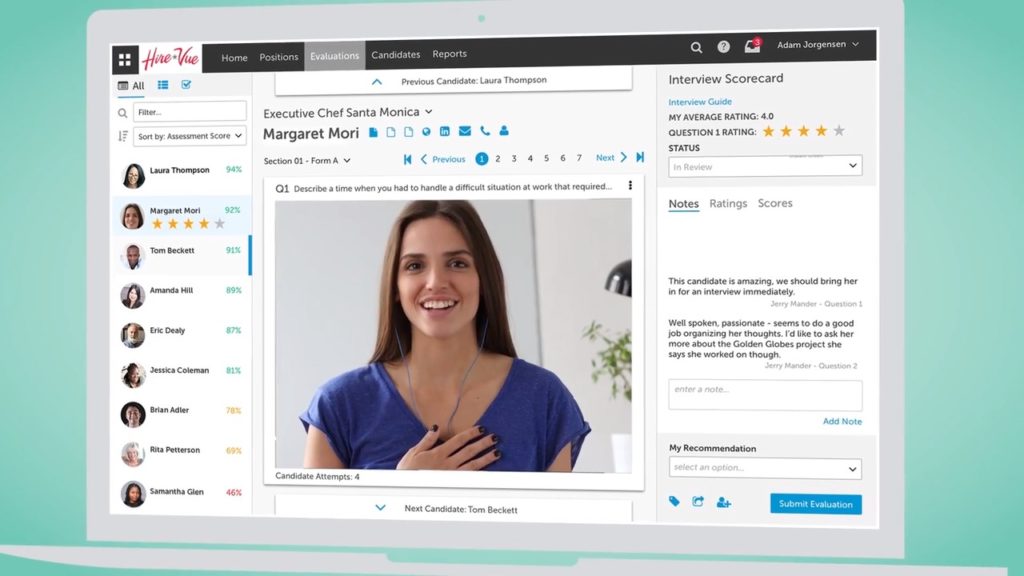Assessing HireVue’s Algorithmic, Video-Based, Assessment

Humans are notoriously lousy decision makers, especially when it comes to hiring. To help streamline that process, HireVue has introduced algorithmic-based video-assessment to help companies make better hiring decisions. Over 700 companies have adopted this new approach, but is that the right decision?

Humans are notoriously lousy decision makers. We are inconsistent, irrational, and systematically biased. This is true for decisions large and small — from recommending jokes to determining parole sentences. One domain in which this phenomenon has posed a particular challenge is in corporate hiring, which has far-reaching implications for success and productivity at both the individual and firm level.
In recent years, a number of technology-based interventions have been implemented to assist humans in the traditionally challenging hiring process — from start-ups like AlleyO who have developed “recruiting automation bots” to manage candidate engagement via text message to companies like Comeet that leverage “intelligent workflows” to coordinate the flow of information between hiring managers and candidates.
More recently a company called HireVue has captured the attention of companies, candidates, and regulators by taking an even larger role in the hiring process. HireVue has built an artificial intelligence hiring system that asks candidates’ to participate in video-based assessments that analyze tens of thousands of factors including facial movements, word choice and speaking voice to develop an “employability” score. This employability score has served as the basis for hiring decisions for over 700 of HireVue’s customers including Hilton, Unilever and the Boston Red Sox. While some (including candidates and regulators) have expressed a number of concerns about HireVue’s system, I believe HireVue’s system presents a promising next step in algorithmic-based hiring.
HireVue’s system presents several key benefits to companies who are looking to revamp their hiring processes. First, automated video assessments are much faster than human interviews. For Hilton, automated interviews for reservation-booking, revenue management, and call center positions reduced hiring time from six weeks to five days. This not only saves valuable recruiting time but also a substantial amount of money. For Unilever, HireVue also helps save the organization approximately 100,000 hours of recruiting time and roughly one million dollars per year. The system is easily scalable, and for some, can help increase the diversity of candidates hired (e.g. at Unilever, HireVue helped steer hiring managers away from “mini-mes” and boosted diversity hires by 16 percent.)
Nonetheless, as HireVue attracts an increasing number of customers, the company faces mounting criticism. In November 2019, the Electronic Privacy Information Center (EPIC) filed a complaint to the FTC arguing that HireVue’s system is, “Biased, Unprovable, and Not Replicable.” Other AI researchers have argued that HireVue’s platform is “opaque” and “profoundly disturbing.” And in Illinois, Governor Pritzker signed a law that forces employers to explain to job applicants the mechanisms behind AI-hiring systems, like HireVue’s.
Like many of HireVue’s critics, I, too, believe we should strive for hiring processes that are consistent, replicable and unbiased; however, prohibiting the use of algorithmic-based hiring processes is counterproductive to those goals. It would seem that critics of HireVue’s system are in fact holding algorithmic-based systems to a different standard than that of human decision makers. If we are too quick to dismiss the value of automated hiring processes, my fear is that we will be left with the human-dependent processes which are more inconsistent, less replicable, and more biased.
Unlike human decision-makers, algorithmic-based models provide us with an opportunity to truly understand the factors that went into each hiring decision. With algorithms, we are able to precisely indicate how much weight to give certain traits or behaviors and can guarantee that those weights are applied consistently across candidates. This level of control and granularity will simply never be possible with a team of human decision-makers, even with robust training.
Consequently, rather than focusing on the ways in which algorithmic-based systems like HireVue’s fall short of the ideal, our time may be better spent identifying ways to increase candidates’ comfort with these new systems. While the transition from human-based interviews to AI-based is unlikely to be smooth, there is no reason it needs to feel alienating and dehumanizing, as some interviewees have expressed. To help facilitate acceptance of these new systems, it would therefore be wise for hiring teams to allocate the time previously spent interviewing candidates to finding new ways to make algorithmic-based hiring feel more human.
Article: Washington Post: A face-scanning algorithm increasingly decides whether you deserve the job



Although I understand the potential efficiency of automatized video-assessment, I am skeptical that you can measure precisely a person’s ability to communicate with other humans using a recorded interview where the candidate was speaking to a camera with no or little human interaction.
Some people might feel uncomfortable/weird speaking to a camera, despite being excellent face-to-face communicators, good at articulating arguments when interacting with another human being and/or adaptative (in tone, speed or length of responses) based on its interlocutor’s non-verbal communication signs. Likewise, other poor in-person communicators might have the opposite effects and feel less nervous and more confident speaking to a machine rather than to another human being.
Therefore, I believe that a product like HireVue should be a complement, but not a substitute for in-person assessments.